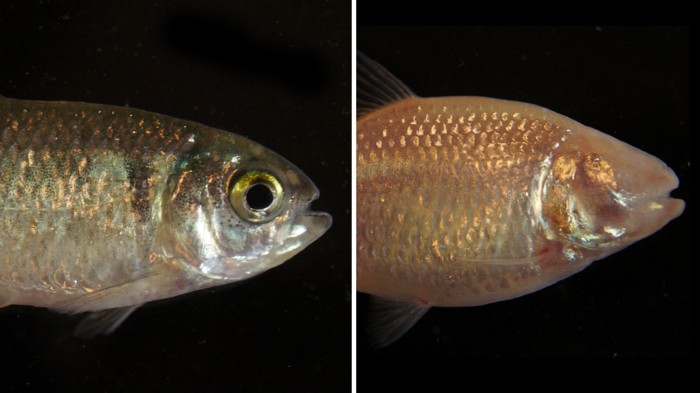Not only do all species vary in ability and behaviour, but fundamental biological needs are subject to variation across the animal kingdom. This evolutionary diversity is reflected in the difference in amount of sleep necessary for each species (1). Although the considerable variation in sleep is recognized, little information is known about the evolutionary basis that drives the emergence of such diversity.
A prominent example of sleep variation has recently been studied (2), comparing the Mexican cavefish (3) found in the Sierra del Abra region of Northeast Mexico, to their existing surface ancestors. Multiple Pachón cavefish populations have independently evolved to sleep up to 80% less than the surface dwelling species, with no apparent adverse effects on their function or health.

Figure 1: A comparison of Astyanax mexicanus , the blind Mexican cavefish (right) to their relatives that live on the surface (left) Credit: J. B. Jaggard et al./eLife/CC BY 4.0
Figure 1: A comparison of Astyanax mexicanus , the blind Mexican cavefish (right) to their relatives that live on the surface (left) Credit: J. B. Jaggard et al./eLife/CC BY 4.0
The Pachón cavefish have smaller, if not absent, eyes and lack pigment as shown in Figure 1. The enlarged hypothalamus of the Pachón cavefish has been reported, attributing to many behvioural differences from the surface counterparts. It is thought that ecological differences that affect food availability have driven this evolutionary variation in not only the physical features of these species but also in their sleep behaviour (4).
Investigation into to the regulation and expression of hcrt, a highly conserved peptide known to alter sleep in other species, has offered insight in the sleep variation observed in the Mexican cavefish. Researchers found that although the genetic sequence of this regulatory peptide is identical in the adult Pachón and surface cavefish, there is significant increase in the expression of hcrt in adult Pachón (Figure 2).

Figure 2: HCRT Expression in Pachón (orange) and Surface (blue) Cavefish
Figure2: HCRT Expression in Pachón (orange) and Surface (blue) Cavefish
The adult Pachón cavefish expressed the HCRT peptide four times more than the surface species. With this finding, researchers tested how inhibiting this particular peptide would affect the sleep behaviour of the Pachón species. When HCRT expression was suppressed in the Pachón cavefish, increases in time spent sleeping were observed, confirming the dependence of their sleep behaviour on the HCRT peptide.
-Jojo Nijjar
References:
1. Campbell, S. S.; Tobler, I. Neuroscience & Biobehavioral Reviews . 1984, 8,269–300.
2. Jaggard, J.B.; Stahl, B. A.; Lloyd, E.; Prober, D.A.; Duboue, E.R.; Keene, A.C. Life Sciences Journal. 2018, e32637.
3. Keene, A.; Yoshizawa, M.; McGaugh, S. Biology and Evolution of Mexican Cavefish. San Diego, USA, 2016.
4. Menuet, A.; Alunni, A.; Joly, J.S.; Jeffery, W.R.; Rétaux, S. Development. 2007, 134, 5, 845-55.
5. Siegel, J.M. Nature. 2005, 437, 1264-71.


